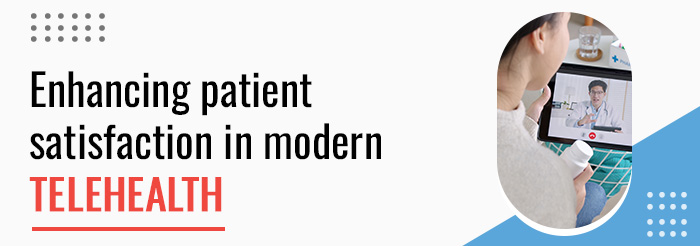Enhancing patient satisfaction in modern telehealth
Posted on
In today’s rapidly evolving healthcare landscape, patient satisfaction stands as a crucial metric for evaluating the quality of care provided. With the advent of telehealth, patient engagement has taken on a new dimension, offering innovative ways to improve the healthcare experience for both patients and providers. In this blog post, Practice Builders delves into the significance of patient engagement in telehealth, explores strategies to measure and improve patient engagement, and discusses the benefits of high-quality telehealth services.
Understanding Patient Satisfaction in Healthcare
Patient satisfaction is crucial in the healthcare industry, particularly in telehealth, where patients see doctors through video or chat instead of in person. It’s essential to ensure patients feel valued and respected by their healthcare providers. Telehealth can be particularly helpful for those who can’t easily access the doctor’s office or need quick advice. To ensure patient satisfaction, healthcare providers should listen to their feedback, make telehealth easy to use, and provide good care.
One way to do this is by asking patients about their experiences and what they liked or disliked. Additionally, making telehealth easy to use involves using simple tools for online communication and scheduling appointments.
In the context of telehealth, patient satisfaction becomes even more vital as it directly impacts the adoption and success of remote healthcare services. Patients must feel engaged and satisfied with their telehealth experiences to continue using virtual care services.

Why Telehealth is Crucial for Healthcare Patient Engagement
Telehealth plays a pivotal role in improving patient engagement in healthcare. By combining modern technologies, telehealth offers convenient and accessible options for patients to interact with healthcare providers. Whether through video consultations, remote monitoring, or mobile health apps, telehealth bridges the gap between patients and providers, focusing on better engagement and participation in healthcare decision-making.
Making the appointment process easier
One of the key benefits of telehealth is its ability to streamline the appointment process, making it easier and faster for patients to schedule consultations with their healthcare providers. Through online appointment scheduling platforms and telemedicine apps, patients can book appointments at their convenience, removing the need for time-consuming phone calls or waiting times.
Minimizing missed appointments
Missed appointments pose a significant challenge in the traditional healthcare environment, leading to wasted resources and compromised patient care. Telehealth helps to deal with this issue by offering flexible scheduling options and reminders for upcoming appointments. Patients are more likely to attend virtual consultations, reducing the likelihood of missed appointments and improving overall patient engagement.
Expanding access to far-located regions
Telehealth removes geographical barriers, enabling patients in remote or underserved areas to access quality healthcare services. By combining telemedicine technologies, healthcare practitioners can reach patients who would otherwise face challenges in accessing timely care. This expansion of access enhances patient engagement by ensuring that all individuals, regardless of location, have the opportunity to receive comprehensive healthcare services.

Measuring and maximizing patient engagement
Measuring patient engagement in telehealth is essential for optimizing the quality of care and enhancing patient satisfaction. Healthcare organizations can employ various strategies to gauge and maximize patient engagement in the field of virtual care.
Utilizing patient feedback surveys
Patient feedback surveys provide valuable insights into the patient experience and satisfaction levels with telehealth services. By regularly collecting and analyzing patient feedback, healthcare providers can identify areas for improvement and tailor their telehealth services to better meet patient needs.
Monitoring utilization metrics
Tracking utilization metrics such as appointment attendance rates, session duration, and patient adherence to treatment plans can offer valuable insights into patient engagement levels. Analyzing these metrics allows healthcare organizations to assess the effectiveness of their telehealth programs and make data-driven decisions to optimize patient engagement.
Promoting interactive communication
Effective communication is essential for improving patient engagement in telehealth. Practice Builders believes that healthcare providers should prioritize interactive communication channels, such as secure messaging platforms and video consultations, to make meaningful interactions with patients easier to attend. By actively engaging patients in their care journey, providers can strengthen patient-provider relationships and enhance overall satisfaction with telehealth services.

The Benefits of High-Quality Telehealth Services
Investing in high-quality telehealth services yields numerous benefits for both patients and healthcare providers. From improved access to care to enhanced patient satisfaction, the impact of telehealth extends far beyond traditional healthcare delivery models.
Enhanced patient convenience
Telehealth is a game-changer when it comes to healthcare by providing patients with convenient access to services from the comfort of their own homes. This technology eliminates the stress and hassle of traveling to a doctor’s office, finding parking, and waiting in crowded waiting rooms.
Telehealth also reduces wait times, allowing patients to schedule appointments sooner, sometimes even on the same day. This quick access to care leads to better outcomes and higher levels of patient satisfaction. The convenience of telehealth also plays a crucial role in patient engagement, as it encourages active participation in their care, empowering patients to take control of their health without disrupting their daily routines.
Improved care coordination
Telehealth is revolutionizing healthcare by enabling healthcare providers to play a key role in enhancing patient satisfaction. By focusing on patient engagement, healthcare providers can tailor their services to better meet patient needs and create meaningful interactions. By actively seeking and incorporating patient feedback, healthcare providers can gain valuable insights into areas for improvement and tailor their services to better meet patient needs. Implementing effective patient engagement strategies, such as fostering open communication channels, utilizing patient education materials, and promoting shared decision-making in treatment planning, can strengthen the patient-provider relationship and foster a sense of ownership over one’s health.

Furthermore, embracing telehealth technologies, such as user-friendly platforms and innovative tools like remote monitoring devices and mobile health apps, can optimize patient satisfaction and improve healthcare outcomes. By prioritizing patient engagement and delivering high-quality virtual care services, healthcare organizations can pave the way for a more patient-centered approach to healthcare services in the digital age.
Personalized patient experience
Telehealth is changing healthcare by providing personalized care without it being an unknown secret for the patient. It enables patients to track their health metrics and share real-time data with healthcare providers. This proactive management of chronic conditions and early intervention leads to better health outcomes. Telemedicine consultations allow patients to discuss concerns, ask questions, and actively participate in decision-making. This personalized patient experience fosters empowerment, ownership of health, and healthy behaviors. This approach strengthens the patient-provider relationship, promoting long-term engagement in healthcare.
Conclusion
In conclusion, improving patient satisfaction in modern telehealth requires a huge effort to prioritize patient engagement and deliver high-quality virtual care services. A healthcare digital marketing agency like Practice Builders stands by the point that, by making use of patient feedback, implementing effective engagement strategies, and embracing telehealth technologies, healthcare organizations can optimize patient satisfaction and improve overall healthcare outcomes in the digital age.

 Reaching The Right Audience Through Target Marketi..
Reaching The Right Audience Through Target Marketi.. Key Elements Affecting Your Website’s Performanc..
Key Elements Affecting Your Website’s Performanc.. Proactive vs. Reactive Healthcare: Deep Guide
Proactive vs. Reactive Healthcare: Deep Guide